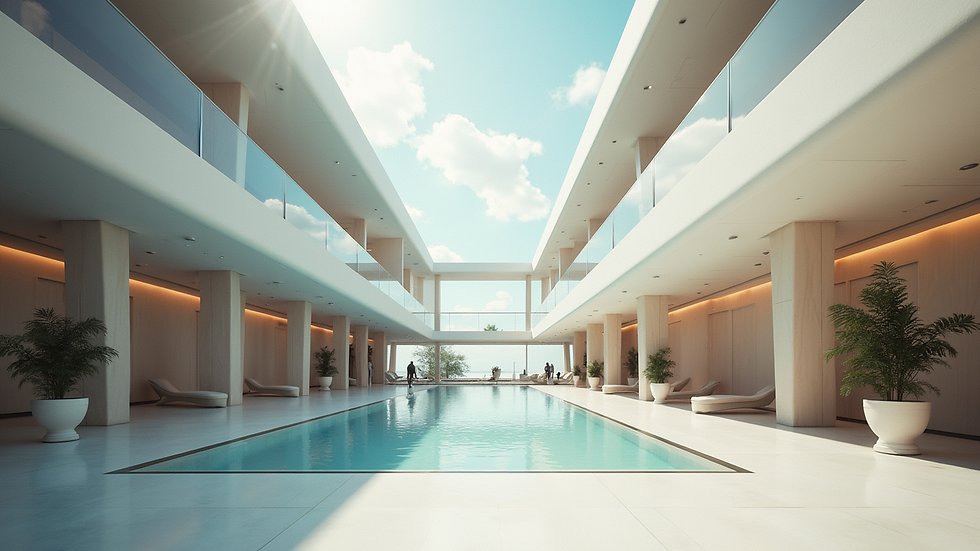How Technology is Transforming Architectural Visualization
- Munjal Padia
- Sep 5
- 4 min read
Architectural visualization has undergone a remarkable transformation in recent years, thanks to rapid advancements in technology. What was once a labor-intensive process involving hand-drawn sketches and physical models has evolved into a dynamic, digital experience. Today, architects, designers, and clients can explore detailed, lifelike representations of buildings before construction even begins. This shift is not only enhancing creativity but also improving communication and decision-making throughout the design process.
The Evolution of Architectural Visualization
Architectural visualization started with simple sketches and physical models that provided a basic idea of a building's design. These methods, while effective in their time, had limitations in terms of detail, flexibility, and the ability to convey the full experience of a space.
With the advent of computer-aided design (CAD) software, architects gained the ability to create more precise and scalable drawings. However, these were still largely technical and lacked the immersive quality needed to fully understand a design's impact.
The real game-changer came with the integration of 3D modeling and rendering technologies. These tools allow for the creation of photorealistic images and animations that bring architectural concepts to life. Clients can now virtually walk through a building, experience lighting changes, and see how materials interact in different environments.

This evolution has made architectural visualization an essential part of the design process, enabling better collaboration and more informed decisions.
How Architectural Visualization Enhances Design and Communication
Architectural visualization is not just about creating pretty pictures. It plays a crucial role in enhancing design quality and improving communication among stakeholders.
Improved Client Understanding: Visualizations help clients who may not be familiar with architectural drawings to understand the design intent clearly. This reduces misunderstandings and ensures that the final product aligns with their expectations.
Design Iteration and Experimentation: Architects can quickly test different design options, materials, and lighting conditions. This flexibility leads to more innovative and refined designs.
Marketing and Presentation: High-quality visualizations are powerful marketing tools. They can be used in presentations, brochures, and online platforms to attract investors and buyers.
Cost and Time Efficiency: Identifying design flaws early through visualization can prevent costly changes during construction. It also speeds up the approval process by providing clear and convincing representations.
By integrating these benefits, architectural visualization bridges the gap between imagination and reality, making the design process more transparent and effective.
What is a 3D rendering?
A 3D rendering is a digital image or animation created from a three-dimensional model using specialized software. It simulates how a building or space will look in real life, including textures, lighting, shadows, and reflections.
Unlike traditional drawings, 3D renderings provide a realistic and immersive view of architectural designs. They can be static images or dynamic walkthroughs, allowing viewers to explore every angle and detail.
For example, a 3D rendering of a residential building might show the exterior facade with realistic materials like brick or glass, the interior layout with furniture, and even landscaping elements. This level of detail helps clients and architects visualize the final outcome accurately.
Many firms now rely on 3d rendering services to produce these visuals, leveraging advanced software and skilled artists to create compelling representations that support design decisions and marketing efforts.

Emerging Technologies Shaping Architectural Visualization
Several cutting-edge technologies are driving the transformation of architectural visualization, making it more interactive, accessible, and realistic.
Virtual Reality (VR) and Augmented Reality (AR)
VR allows users to immerse themselves in a fully digital environment, walking through a building before it exists. This technology is invaluable for client presentations and design reviews, providing a sense of scale and spatial awareness that traditional images cannot match.
AR overlays digital models onto the real world through devices like smartphones or AR glasses. This helps architects and clients visualize how a new structure will fit into an existing environment, enhancing site analysis and planning.
Artificial Intelligence (AI)
AI is being used to automate and optimize various aspects of visualization. For instance, AI algorithms can generate realistic textures, suggest design improvements, or even create entire scenes based on minimal input. This speeds up the workflow and allows designers to focus on creativity.
Real-Time Rendering
Real-time rendering engines enable instant visualization of changes in design, lighting, and materials. This interactivity allows architects and clients to experiment with different options on the fly, making the design process more collaborative and efficient.
Drone Technology
Drones equipped with cameras provide aerial views and site data that can be integrated into visualization models. This enhances accuracy and helps in planning large-scale projects by offering perspectives that were previously difficult to obtain.

Practical Tips for Leveraging Technology in Architectural Visualization
To make the most of technological advancements in architectural visualization, consider the following actionable recommendations:
Invest in Quality Software and Hardware: Use industry-standard tools for 3D modeling, rendering, and VR to ensure high-quality outputs. Powerful computers and graphics cards are essential for handling complex projects.
Collaborate with Skilled Visualization Experts: Partner with professionals who specialize in architectural visualization to create compelling and accurate representations.
Incorporate Client Feedback Early: Use interactive tools like VR walkthroughs to gather client input during the design phase, reducing revisions later.
Stay Updated on Emerging Trends: Technologies evolve rapidly. Regularly explore new tools and techniques to keep your visualization capabilities cutting-edge.
Use Visualization for Marketing: Leverage photorealistic images and animations in promotional materials to attract investors and buyers.
Integrate Visualization into Project Management: Use visual models to coordinate with contractors and suppliers, improving communication and reducing errors.
By following these tips, architects and designers can harness technology to enhance creativity, efficiency, and client satisfaction.
The Future of Architectural Visualization
The future of architectural visualization promises even more exciting developments. Advances in AI, machine learning, and cloud computing will make visualization faster, more accessible, and more intelligent.
We can expect:
Greater Personalization: Customized visualizations tailored to individual client preferences and needs.
Enhanced Collaboration: Cloud-based platforms enabling real-time collaboration among global teams.
Sustainability Integration: Visualization tools that simulate environmental impact and energy efficiency.
Mixed Reality Experiences: Combining VR and AR for seamless interaction between digital models and physical spaces.
As these technologies mature, architectural visualization will become an indispensable part of the design and construction process, driving innovation and improving outcomes.

Embracing these technological advancements will empower architects and clients alike to create better, smarter, and more sustainable buildings for the future.






Comments